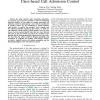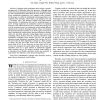ANCS
2010
ACM
13 years 11 months ago
2010
ACM
As we move forward towards the next generation of wireless protocols, the push for a better radio physical layer is ever increasing. Conventional radio architectures are limited t...
ICC
2009
IEEE
14 years 2 days ago
2009
IEEE
Abstract--By using cognitive radio technology, opportunistic spectrum access has the potential to solve the underused spectrum problem. In this paper, we employ class-based call ad...
GLOBECOM
2009
IEEE
14 years 3 days ago
2009
IEEE
Collaborative spectrum sensing in cognitive radio networks has been proposed as an efficient way to improve the performance of primary users detection. In collaborative spectrum se...
MASS
2010
14 years 6 days ago
2010
Cognitive radio, which enables dynamic access of under-utilized licensed spectrums, is a promising technology for more efficient spectrum utilization. Since cognitive radio enables...
GLOBECOM
2010
IEEE
14 years 9 days ago
2010
IEEE
Abstract--The information propagation speed (IPS) of a network specifies how fast the information can be transmitted in a network. In this paper, we derive an IPS upper bound in co...
GLOBECOM
2010
IEEE
14 years 9 days ago
2010
IEEE
With the employment of cognitive radio technology, dynamic spectrum management has the potential to solve the underused spectrum problem. In this paper, we introduce and compare tw...
DSD
2010
IEEE
14 years 10 days ago
2010
IEEE
Orthogonal Frequency Division Multiplexing (OFDM) can provide a flexible usage of the spectrum by controlling individual subcarriers. Sets of subcarriers can be zero-modulated to a...
WICOMM
2010
14 years 20 days ago
2010
Cognitive radio (CR) has been considered a key technology to enhance overall spectrum utilization by opportunistic transmissions in CR transmitter-receiver link(s). However, CRs m...
TCOM
2010
14 years 21 days ago
2010
Abstract—Cognitive radio technologies have become a promising approach to efficiently utilize the spectrum. Although many works have been proposed recently in the area of cognit...
ITIIS
2010
14 years 23 days ago
2010
Cognitive Radio is an advanced enabling technology for the efficient utilization of vacant spectrum due to its ability to sense the spectrum environment. It is important to determ...


